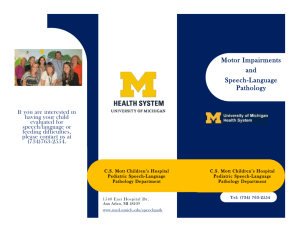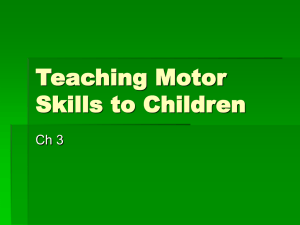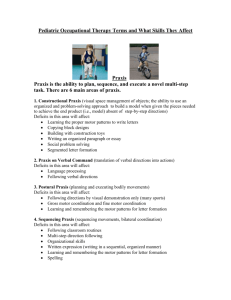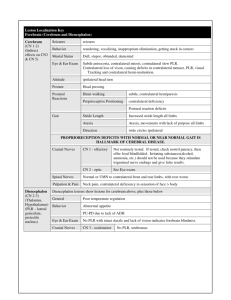to - Oncology Section
advertisement
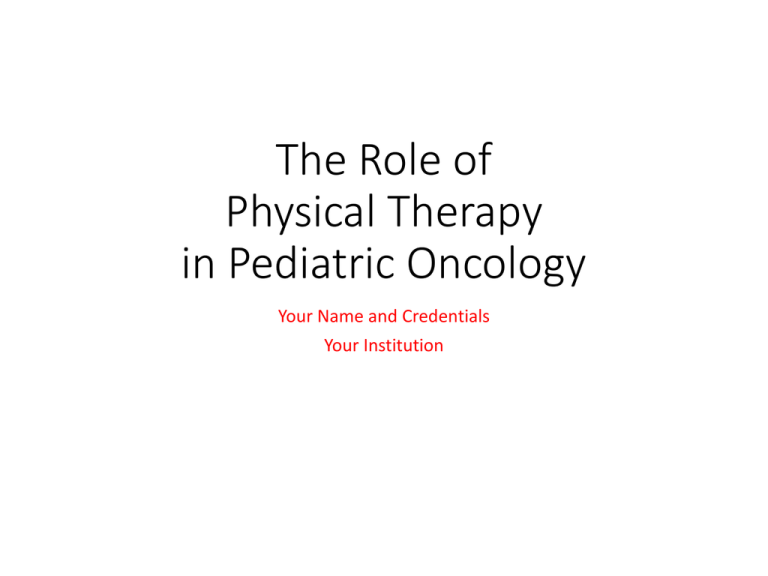
The Role of Physical Therapy in Pediatric Oncology Your Name and Credentials Your Institution Tracking Utilization • To track utilization of this resource, please email the Pediatric Oncology SIG chairs with the final version of your presentation. Any feedback is also welcome! • Susan Miale (susan.miale@stonybrook.edu) • Kristin Brown (kbrown8@lifespan.org) Instructions for Use • This presentation is meant to be used as a TEMPLATE that can be personalized for each practice setting and/or clinic site. • This is a starting point for education to other medical professionals. Expand and adapt to the target audience as appropriate to provide the best possible information. • Suggestions for personalization are HIGHLIGHTED IN RED and have been provided for: • areas of focus • places to add to slides • places to add other bullet points Objectives At the conclusion of this activity, the participant will be able to: • Identify the side effects of cancer and cancer treatment that necessitate physical therapy (PT) in the developing child • Demonstrate knowledge of typical motor development • Recognize the role of PT for children with oncological diseases • Discuss how to effectively screen patients to determine the need for PT services • Recognize the benefits of collaboration with the medical team to optimize rehabilitation outcomes • ADD ADDITIONAL OBJECTIVES AS NECESSARY Why should Physical Therapists be involved? **See Notes section** • Health status of adult survivors compared to siblings General Health OR 2.5 Functional Impairment OR 5.7 Mental Health OR 1.8 Activity Limitations OR 2.7 Hudson et al. 2003 The Role of PT in Pediatric Oncology • Disease and treatment occur during a critical point of development in pediatric cancer • Children have not yet acquired mature posture, gait, motor skills, cognitive skills, social skills, etc. • The process can alter the course of development • Early screening and PT intervention is crucial to minimize long term impairments / activity limitations for children with cancer Provide Case Study (EXAMPLE) • Based on your patient population (i.e. neuro, hem-onc, ortho, etc.) • Focus on long-term outcomes Side Effects of Cancer Treatment Related to Physical Therapy Cancer Treatment Side Effects Influencing PT • Chemo-Induced Peripheral Neuropathy (CIPN) • Steroid Myopathy • CNS Effects • Cardiac Effects / Decreased Endurance • Fatigue • Edema • Avascular Necrosis (AVN) • Orthopedic Procedures Silver & Gilchrist 2011 Neuropathy in Pediatric Cancer Patients • 83% of children treated with vincristine for non-CNS cancers have ped-mTNS Score > 4 • Clinical Testing Deficits: • • • • • Light Touch 44% Pin Sensation 46% Vibration Sensation 37% Strength 98% Deep Tendon Reflexes 100% • Higher scores on ped-mTNS associated with balance and manual dexterity deficits Gilchrist & Tanner 2013 Cardiotoxicity • Patients treated by anthracyclines or mediastinal/neck radiation are at risk for cardiotoxicity (Shankar 2008) • Early evidence shows that exercise may be beneficial prior to, during, and post anthracycline treatment (Jensen et al. 2013, Scott et al. 2013) • Combination of strength training and aerobic training is beneficial in patients with chronic heart failure • Both are important to consider when treating patients at risk for cardiotoxicity Bartlo et al. 2007 Expand on Side Effects • Put additional slides here to expand on side effects as they relate to your primary patient population (i.e. SCT/BMT, ortho, neuro, etc.) Common Impairments in Children with Cancer • Loss of ROM • Pain • Posture dysfunction • Gait disturbances • Muscle weakness • Sensory impairments • Balance impairments • Motor skills impairments • Poor endurance • Expand or be concise depending on time of presentation (**See NOTES section) Activity and Participation Limitations • Impairments can lead to restrictions in the following activities: • • • • • • Activities of Daily Living (ADLs) – dressing, eating, etc. School Participation with peers and siblings Sports Age-Appropriate Play Family and community outings Role of PT Intervention • Recently published systematic review of exercise interventions in children with cancer • Most studies involve supervised hospital-based exercise programs and home-based activity programs • Improvements demonstrated in: • • • • Cardiopulmonary endurance Strength Fatigue Physical function Huang & Ness 2011 ADD CASE EXAMPLES Screening for PT Services Questions to Ask Skills to Demonstrate Screening Interview • Has your child had any difficulty keeping up with his or her siblings or peers? • Has your child had any pain in the last 2 weeks? • Can you child participate in all activities at school or at home that they could participate in prior to diagnosis? • Examples: playground, coloring/writing, physical education classes Screening Physical Examination **See NOTES section • Range of Motion (ROM) • Ankle dorsiflexion if being treated with vincristine • Strength • Floor to stand transfer (use of hands) • Gait • Ask if gait changes with fatigue • Balance • Single leg stance • Motor Skills • Jumping, hopping Typical Motor Development **See NOTES section Typical Motor Skills (Campbell et al. 2012) Age (yrs) Gross Motor Fine Motor 1 Walking, Crawl up stairs Picking up cheerio (pincer grasp); Banging toys together 2 Squat to stand, early Running, Jumping, Walks up/down stairs with rail, Kicks ball, Throw/catch Colors with whole-hand grasp; Uses spoon Undressing self 3 Heel-toe gait, Running, Stairs with/without rail- step over step going up, One leg balance 3 sec, Riding a tricycle Tripod grasp; imitating scribbles; Puts on pants, socks, shoes; buttons difficult 4 Hopping, Galloping, Catching using only hands; step-over-step down stairs, Climb on play structures Drawing circle/square Using scissors; button/un-button large buttons; zippers 5 Skipping, jumping jacks, Riding a bike, Long jump, Jump rope, Climb Copies triangle; cuts shapes; Draws person/letters Typical Motor Skills Age Gross Motor Fine Motor 6-10 years Hopping side to side Jump rope Single leg stance 5-10 sec eyes closed Participates in youth sports Write during school day without hand fatigue 10-21 years Mile run 20 single leg calf raises Completes Presidential Fitness testing Involved in sports teams, weight training, etc. Complete all daily tasks without hand fatigue Recommended Activity Levels • Age 1 – 3 years • 30 minutes planned activity, 60 minutes unstructured activity / day • Age 3 – 5 years • 60 minutes planned activity, 60 minutes unstructured activity / day • Age 6 – 17 years • 60 minutes/day of moderate/vigorous physical activity • Can add small increments to total 60 minutes • Can include aerobic, strength, bone-building activities • On a scale of 0-10, a 5-6 is moderate, a 7-8 is vigorous http://kidshealth.org/parent/nutrition_fit/fitness/exercise.html# http://www.cdc.gov/physicalactivity/everyone/guidelines/children.html Referrals to Rehabilitation Rehabilitation Service Referral? • Consider the following when deciding on rehabilitation service referral: • • • • Age of child Severity of deficits Duration of deficits and time in treatment Family readiness • Mild deficits that last longer than 2 – 4 weeks are worth a referral as they may delay acquisition of new motor skills in the future • Example: Decreased running speed will cause a child to be discouraged in participating in recreational activities with peers, possibly leading to sedentary lifestyle, obesity and social isolation. Referrals • Physical Therapy • Deficits in ROM, balance, strength, gross motor skills, endurance • Occupational Therapy • Deficits in fine motor skills, regression in ADLs (dressing, bathing, etc.), feeding issues, cognitive issues • Speech Language Pathology • Articulation, language reception, cognitive, feeding issues How and When to Refer • **Provide specific information for your site.** Team Approach • Collaboration and communication is critical • It is important for all team members to communicate the role of PT to the child and family • Ask questions about current exercise level • Encourage exercise and PT • Regular communication between PT and medical team regarding safety of and response to exercise • Lab values, precautions/contraindications, cardiac status, adverse effects of exercise • Opportunities for future research collaboration (site specific) Summary • Children and adolescents with cancer often have a high rehabilitation potential. • A team approach is necessary to optimize rehabilitation outcomes and family compliance. • Exercise can be worked into the daily routine of a child so as not to overwhelm a family that is already stressed. • ADD HERE! References • Bartlo P. Evidence-based application of aerobic and resistance training in patients with congestive heart failure. J Cardiopulm Rehabil Prev. 2007;27(6):368-375. • Campbell S, Palisano RJ, Orlin MN, eds. Physical Therapy for Children, 4th Edition. St. Louis, MO: Elsevier Saunders, 2012. • Centers for Disease Control and Prevention. Physical Activity for Everyone: Guidelines: Children. 9 Nov 2011. Available at http://www.ckc.gov/physicalactivity/everyone/guidelines/children/html. Accessed January 1, 2014. • Gilchrist LS, Tanner L. The pediatric-modified total neuropathy score: a reliable and valid measure of chemotherapy-induced peripheral neuropathy in children with non-CNS cancers. Support Care Cancer. 2013;21(3):847-856. • Huang TT, Ness KK. Exercise interventions in children with cancer: a review. Int J Pediatr. 2011;2011:461512. • Hudson MM, Mertens A, Yasui Y, et al. Health status of adult long-term survivors of childhood cancer. JAMA. 2003;290:1583-1592. • Jensen BT, Lien CY, Hydock DS, Schneider CM, Hayward R. Exercise mitigates cardiac doxorubicin accumulation and preserves function in the rat. J Cardiovasc Pharmacol. 2013;62(3):263-269. References • Ness KK, Leisenring WM, Huang S, et al. Predictors of inactive lifestyle among adult survivors of childhood cancer: a report from the childhood cancer survivor study. Cancer. 2009;115(9):1984-1994. • Scott JM, Lokoski S, Mackey JR, et al. The potential role of aerobic exercise to modulate cardiotoxicity of molecularly targeted cancer therapeutics. Oncologist. 2013;18(2):221-231. • Shankar SM, Marina N, Hudson MM, et al. Monitoring for cardiovascular disease in survivors of childhood cancer: report from Cardiovascular Disease Task Force of the Children’s Oncology Group. Pediatrics. 2008 Feb;121(2):e387-396. • Silver JK, Gilchrist LS. Cancer rehabilitation with a focus on evidence-based outpatient physical and occupational therapy interventions. Am J Phys Med Rehabil. 2011;90(Suppl 1):S5-15. • The Nemours Foundation. Kids Health: Nutrition and Fitness Center. Available at http://kidshealth.org/parent/centers/fitness_nutrition_center.html. Accessed January 1, 2014. Your Name Your Department Your Contact Information Thank you.


